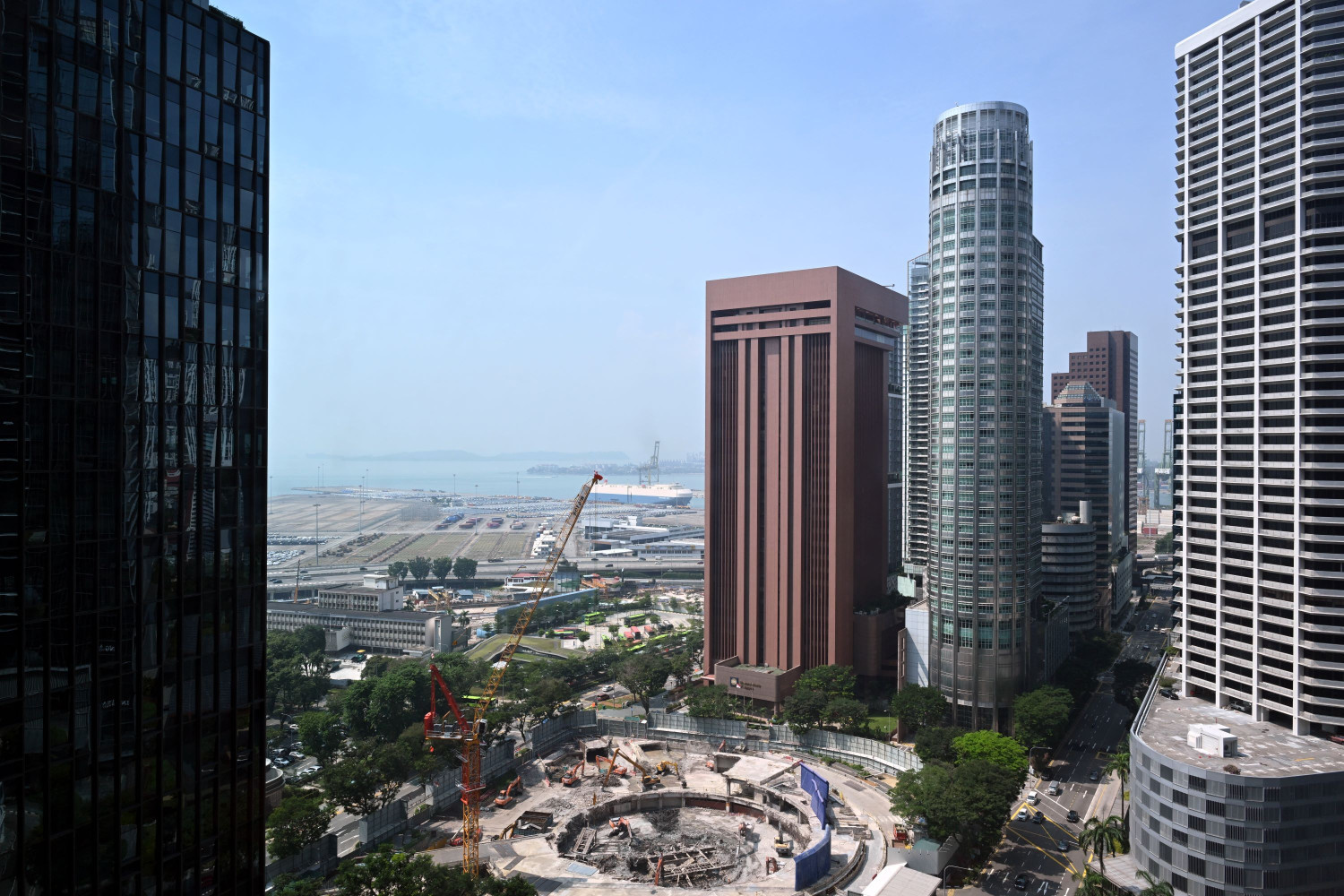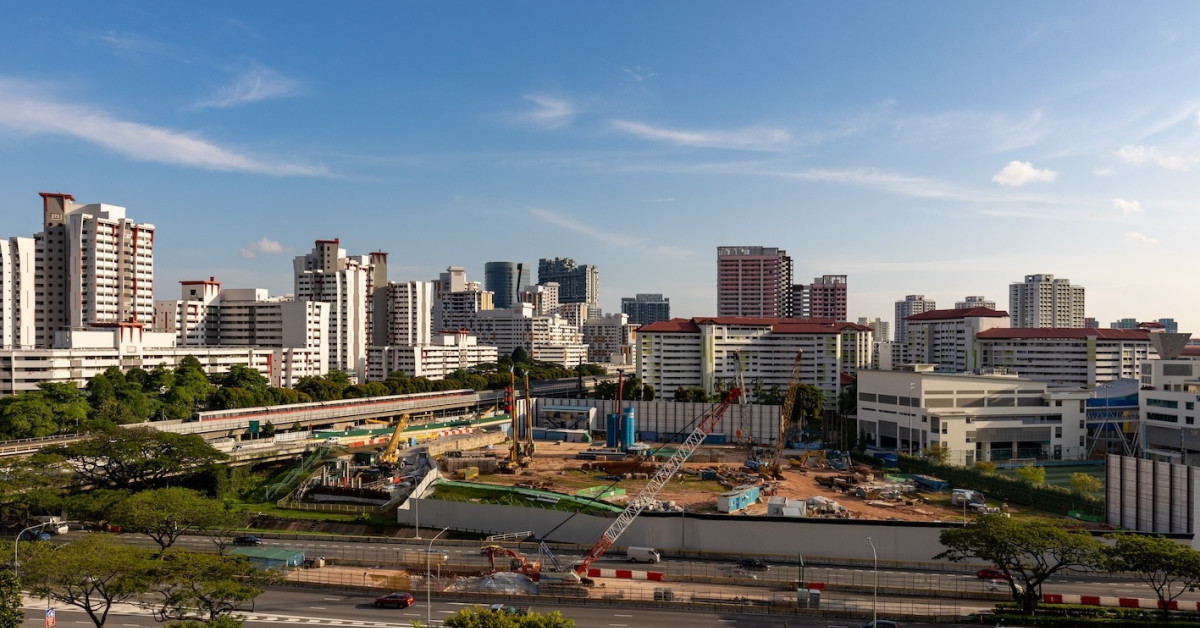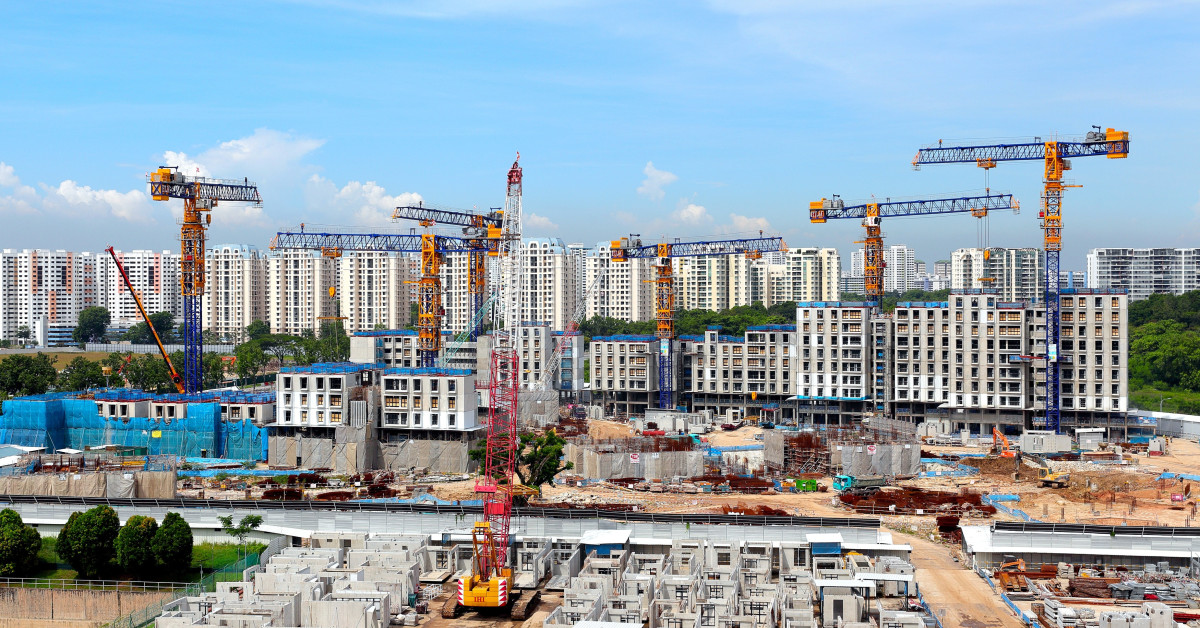Contractors and developers to face skilled labour crunch and high costs in 2024
By Timothy Tay
/ EdgeProp Singapore |
The Skywaters at 8 Shenton Way, which is now under construction, is set to be Singapore’s tallest skyscraper when it is completed in 2028. (Picture: Albert Chua/The Edge Singapore)
Singapore’s construction sector has enjoyed a year of reprieve as developers and builders finally put most of the supply-chain disruptions and backlog of projects behind them. This year, demand and output levels in the construction sector are expected to be on a par with its performance in 2022.
Khoo Sze Boon, managing director for Singapore and Vietnam, Turner & Townsend, forecasts that construction demand for the entire 2023 will range from $27 billion to $32 billion, while overall output for the sector will range from $30 billion to $33 billion. Last year, construction demand amounted to $29.79 billion while output was $30.2 billion, according to statistics from the Building and Construction Authority.
However, market sentiment among stakeholders in the built environment industry are still cautious amid the high interest rate environment that is pushing up costs. Meanwhile, labour shortages are not as acute compared to 2020/2021, but changes to the dependency ratio ceiling (DRC) from January next year could impact productivity, says Aaron Foong, managing director of KTP Consultants, a member of Surbana Jurong Group.
Advertisement
Headline projects in 2024
The local construction sector is on track to be one of the top contributors to Singapore’s economic growth this year, says Scott Halyday, director of Linesight Singapore. “For 2023, the construction sector is forecast to grow by 6.3% as both public- and private-sector construction output rose,” he says.
Much of the growth in construction output this year was buoyed by an improvement in tourism activity, the growth in wholesale and retail trade construction demand, as well as new data centre projects, says Halyday.

Halyday: For 2023, the construction sector is forecast to grow by 6.3% as both public- and private-sector construction output rose. (Picture: Linesight)
Notable private-sector projects that have contributed to the positive construction output this year include the redevelopment of 8 Shenton Way (former AXA Towers) into The Skywaters mixed-use development, as well as en bloc projects like Ming Arcade at 21 Cuscaden Road, and the redevelopment of Tanglin Shopping Centre at 19 Tanglin Road, says Foong.
“In the public sector, there are several ongoing projects such as the second phase of the Cross Island MRT Line as well as future projects like the 12ha Toa Payoh Integrated Development and the redevelopment and extension of Woodlands Checkpoint,” says Foong.
In October, the Land Transport Authority awarded the construction contracts of two interchange stations under the Cross Island Line. The $447 million contract for the design and construction of King Albert Park Station was awarded to China Communications Construction Co (CCCC), while the $514 million design and construction contract for Clementi Station was awarded to a joint venture between CCCC and Sinohydro Corp.
Construction demand will get a further shot in the arm next year when work begins on the extensions to the two integrated resorts — Resorts World Sentosa and Marina Bay Sands. According to Khoo, work packages relating to both two projects will be tendered and awarded next year.
Advertisement
Marina Bay Sands is planning a fourth tower which will feature 1,000 hotel rooms, a 15,000-seater entertainment arena, exhibition halls, luxury retail, and a new sky roof with a swimming pool. Construction work on the $4.5 billion expansion is expected to start by April next year. Meanwhile, Resorts World Sentosa says it will complete expansions to Universal Studios Singapore and the SEA Aquarium next year.
Khoo says some of the advance construction tenders and work packages for the future Changi East/Terminal 5 may also be issued and awarded next year. Construction of the new air freight and three-runway system is expected to start in 2025.
Greater caution in project financing
The higher interest rate environment this year has also seen the cost of financing projects increase this year, says Khoo. “For many developers, we anticipate greater caution in project phasing, particularly for larger-scale projects,” he says, adding that contractors are likely to favour well-balanced payment terms.
“This will have an overall positive impact on risk management. When payment terms are more balanced, it typically results in less risk pricing by contractors. This translates into more-competitive tender prices as a result,” says Khoo.
According to the 3Q2023 Construction Tender Price Index (CTPI) published by the Singapore Institute of Surveyors and Valuers last month, the general tender price index rose slightly to 136.0 last quarter, from 135.8 in 1Q2023. Overall, tender prices remain high compared to 2019 when the index was at 99.9. The CTPI reflects the tender prices received for building projects in Singapore.

“I don’t think we will see labour and material costs fully revert to pre-pandemic levels because the industry has evolved in the way it works and operates over the past few years. In addition, it is a function of demand and supply that heavily influences tender pricing and the price of labour and materials,” says Foong.
Advertisement
He adds that the expected pipeline of construction contracts and tenders next year will drive up demand for labour and materials in Singapore, and he expects prices to respond accordingly.
Halyday says that 2023 saw continued pressure on the supply chain due to global geopolitical volatility coupled with lingering effects of the pandemic. This resulted in elevated costs of raw materials and commodities, as well as longer lead times. “While 4Q2023 might see a calming of these commodity cost impacts, which bodes well for stability in 2024, the ongoing tensions and instability on the global geopolitical front are a cause for concern,” he says.
Linesight is projecting that oil and diesel prices could increase further in the coming quarters, while lumber prices are also expected to stay relatively high into next year. Cement and concrete prices are expected to remain around current elevated levels in the coming quarters.
However, steel prices are expected to continue to decline in the final quarter of this year, with weaker manufacturing output in the US and Europe, and the continued decline of activity in China’s residential sector to keep demand weak.
Labour concerns endure
“The shortage of labour doesn’t seem to have materialised as a major issue this year… but we will be watching the situation cautiously when the revised DRC is enforced next year,” says Foong.
The DRC is the maximum ratio of foreign employees to the total workforce that a company in a given sector can employ. From Jan 1 next year, the DRC for the construction sector will be reduced from 1:7 (or about 87.5%) to 1:5 (or about 83.3%).
In addition, the Man-Year Entitlement (MYE) framework will be dismantled from Jan 1, 2024. The MYE is a work permit allocation system for workers from China and non-traditional source (NTS) countries, such as India, Sri Lanka, Bangladesh, Myanmar, and the Philippines. The MYE quota allocated to each project depends on the project type and the contract value, and firms that hire from NTS countries and China above their allocated MYE quotas will need to pay a higher levy rate.

Foong: I don’t think we will see labour and material costs fully revert to pre-pandemic levels because the industry has evolved in the way it works and operates over the past few years. (Picture: KTP Consultants
“In 2024, we will have to wait and see what impact these changes [in the DRC and MYE] will have on the local construction sector. In the case of the DRC, we should not underestimate the influence of a reduction in the ratio since our construction industry is still relatively labour-intensive,” says Foong.
These sentiments were echoed by Halyday and Khoo who say that while overall labour pressures have eased, skilled labour shortages remain a significant constraint affecting the industry.
“Although the job vacancy rate in the construction sector decreased to 2.3% in 2Q2023 from 4.0% in 2Q2022, it remains almost twice as high as pre-Covid-19 levels,” says Halyday.
“We have observed that it is becoming more difficult to bring in specific talents, such as quantity surveyors and cost managers with job-specific competencies,” says Khoo, adding: “In addition, the shortage of dormitory spaces for migrant workers has become a challenge as it is now more difficult and costly to secure dormitory spaces.”
Digitalisation turns mainstream
The government’s push to transform the built environment sector, in particular efforts towards digitalisation and sustainability, has become mainstream throughout all levels of the built environment and construction sector in Singapore this year, says Foong.
At a gathering of developers and built environment partners last month, Desmond Lee, Minister for National Development, cited the success of Corenet X in improving the system of regulatory submissions and approvals for development projects. “The system enables built environmental professionals to collaborate digitally on the same building model, allowing potential design conflicts and miscommunications to be resolved much earlier, saving time and cost,” says Lee.
Foong says: “During this transition phase, there will be a fair bit of coordination between stakeholders. But I think if everyone is open-minded, the industry is taking steps in the right direction.”

Geopolitical volatility and lingering effects of the pandemic have resulted in higher costs of raw materials and commodities this year. (Picture: Samuel Isaac Chua/The Edge Singapore)
Singapore is also making good strides towards its target of “80-80-80 in 2023” — a long-term plan to green 80% of all buildings, get 80% of new developments to be certified Super Low-Energy, and achieve an 80% improvement in energy-efficiency.
Halyday says that the government’s push towards sustainability has caused a growing awareness and adoption of green building practices. “For example, the key criterion for the award of new data centres following the Data Centre moratorium in Singapore was that of sustainability, with several submissions proposing state-of-the-art sustainability solutions.”
Beyond a top-down approach, Khoo says that key developers need to take the lead, so that sustainable practices can be adopted holistically further down the value chain rather than in isolation and solely for the benefit of one company.
The year ahead
The construction sector has rounded the corner since 2022 when risk mitigation strategies and smart procurement routes became essential as global industry volatility impacted the prices of key construction materials, says Halyday. “But this year, we have seen improved market conditions (in the local market) with the levelling of prices of key commodities and the resumption of major projects including public housing,” he adds.
As confidence in the construction industry in Singapore gathers pace, Halyday expects an increasing appetite for greener and modern construction methods in line with Singapore’s sustainable development agenda, as well as future-proofing operations against market headwinds.
The availability of skilled labour will continue to limit the potential growth of the local construction industry, even as the government pushes for reform towards a more efficient and productive industry, says Foong. “The construction industry continues to suffer from a shortage of suitable employees and the problem of talent retention. We are seeing fewer graduates from local tertiary institutions, while the employment of graduates from overseas are dependent on work permit quota and/or approval of employment passes,” he says.
Foong adds that demand for professional roles such as project managers, architects, engineers, and quantity surveyors will continue to be elevated, even as the majority of the industry players are going through digital transformation.

Khoo: Higher financing costs will see greater caution among developers in project phasing. (Picture: Samuel Isaac Chua/The Edge Singapore)
“With the general post-Covid-19 business environment stabilised in Singapore, the government is now putting a greater emphasis on moving forward with healthcare, transportation, infrastructure, and public housing projects,” says Khoo. He adds that tender price escalation is expected to continue, albeit at a slower rate, and this will inevitably place pressure on upcoming projects.
Looking ahead, future construction projects will likely emerge in the data centre segment as Singapore further develops into a hub for the Asia Pacific region, while new opportunities will open up in the life sciences segment from pharmaceuticals opting to be located in Singapore, says Halyday.
https://www.edgeprop.sg/property-news/contractors-and-developers-face-skilled-labour-crunch-and-high-costs-2024
Tags: |


Follow Us
Follow our channels to receive property news updates 24/7 round the clock.
Subscribe to our newsletter
Advertisement
Advertisement
Advertisement
Top Articles
Search Articles



